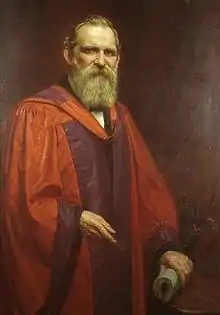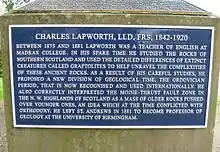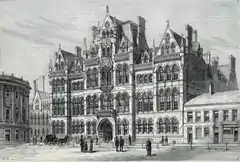Charles Lapworth
Charles Lapworth FRS FGS (20 September 1842 – 13 March 1920) was an English geologist[1] who pioneered faunal analysis using index fossils and identified the Ordovician period.
Charles Lapworth | |
|---|---|
 | |
| Born | 20 September 1842 |
| Died | 13 March 1920 (aged 77) Birmingham, England |
| Awards | Bigsby Medal (1887) Royal Medal (1891) Wollaston Medal (1899) |
Biography
Charles Lapworth was born at Faringdon in Berkshire (now Oxfordshire) the son of James Lapworth.[2]
He was trained as a teacher at the Culham Diocesan Training College near Abingdon, Oxfordshire. He moved to the Scottish border region, where he investigated the previously little-known fossil fauna of the area. There in 1869 he married Janet, daughter of Galashiels schoolmaster Walter Sanderson and stayed in the area. Eventually, through patient mapping and innovative use of index fossil analysis, based on a sequence exposed at Dob's Linn, Lapworth showed that what was thought to be a thick sequence of Silurian rocks was in fact a much thinner series of rocks repeated by faulting and folding.[3]

He completed this pioneering research in the Southern Uplands while employed as a schoolmaster for 11 years at the Episcopal Church school, Galashiels. He then studied geology and became in 1875 an assistant at Madras College in St Andrews, Fife, and then in 1881 the first professor of geology at Mason Science College, later the University of Birmingham, where he taught until his retirement.
He is best known for pioneering faunal analysis of Silurian beds by means of index fossils, especially graptolites, and his proposal (eventually adopted) that the beds between the Cambrian beds of north Wales and the Silurian beds of South Wales should be assigned to a new geological period: the Ordovician.[4] This proposal resolved a long running controversy which began when Roderick Murchison and Adam Sedgwick argued over the relative ages of the strata in question. Lapworth received numerous awards for his research work, while for teaching he used the English Midlands as a setting for demonstrating the fieldwork techniques he had pioneered in his own research.

Following his researches in the Southern Uplands Charles Lapworth also devoted time to mapping near Durness in Scotland's northwest highlands and was first to propose the controversial theory that here older rocks were found lying above younger, suggesting complex folding or faulting as a cause.[6] Later Peach and Horne were dispatched to the area and their monumental memoir proved Lapworth correct.[7][8][9] In the English Midlands he carried out important work in Shropshire, in particular identifying fossils of Olenelloid trilobites of Cambrian age, demonstrating that Cambrian rocks underlay the Carboniferous rocks between Nuneaton and Atherstone, and suggesting a pre-Cambrian date for the Longmyndian rocks that underlay them.[10] He extrapolated these findings to the N.W. Highlands of Scotland, suggesting that the Torridonian sandstone might correspond to the Longmyndian rocks, and thus be pre-Cambrian rather than Cambrian, and that the Durness-Eriboll series, overlaying the Torridonian, would be of Cambrian age rather than Silurian.[5] Again Peach and Horne, surveying in Dundonnell Forest, confirmed Lapworths's suggestion, finding Olenelloid fossils in the fucoid beds of the Durness-Eriboll series.[11] For a modern account and discussion of the elucidation of the geology of the N.W. Highlands, see Oldroyd (1990).[12]
He died on 13 March 1920 and is buried in Lodge Hill Cemetery near Birmingham.
Family
He married Janet Sanderson in 1869.[13]
His son Arthur Lapworth became a renowned chemist and his son Herbert a civil engineer, engineering geologist, stratigrapher and palaeontologist.
Honours and awards
Lapworth received many awards for his work and contributions to geology. In June 1888 he was elected a Fellow of the Royal Society and in 1891 was awarded their Royal Medal.[14] In 1899, he received the highest award of the Geological Society of London, the Wollaston Medal, in recognition of his outstanding work in the Southern Uplands, and Northwest Highlands of Scotland. There years later, in February 1902, he was elected President of the Geological Society for the years 1902–1904.[15]
The glacial Lake Lapworth, was named for him by Leonard Johnston Wills in recognition of his original suggestion of its existence in 1898.[16]
Aberdeen University awarded him an honorary doctorate in 1884 and Glasgow University in 1912 (both LLD).
In 1916 he was elected an Honorary Fellow of the Royal Society of Edinburgh.
Lapworth Museum
Papers relating to Charles Lapworth can be found at the University of Birmingham Special Collections. The University of Birmingham also maintains the Lapworth Museum of Geology within the Aston Webb building on the main Edgbaston campus. The Lapworth Archive, housed in the museum, contains a remarkably complete record of all areas of his research work and teaching.
References
- "Lapworth, Charles". Who's Who. Vol. 59. 1907. p. 1020.
- Biographical Index of Former Fellows of the Royal Society of Edinburgh 1783–2002 (PDF). The Royal Society of Edinburgh. July 2006. ISBN 0-902-198-84-X. Archived from the original (PDF) on 4 March 2016. Retrieved 12 March 2017.
- Lapworth, Charles (1878). "The Moffat Series". Quarterly Journal of the Geological Society. 34 (1–4): 241–346. doi:10.1144/gsl.jgs.1878.034.01-04.23. S2CID 140621558.
- Charles Lapworth (1879) "On the Tripartite Classification of the Lower Palaeozoic Rocks," Geological Magazine, new series, 6 : 1–15. From pp. 13–14: "North Wales itself – at all events the whole of the great Bala district where Sedgwick first worked out the physical succession among the rocks of the intermediate or so-called Upper Cambrian or Lower Silurian system; and in all probability much of the Shelve and the Caradoc area, whence Murchison first published its distinctive fossils – lay within the territory of the Ordovices; … Here, then, have we the hint for the appropriate title for the central system of the Lower Palaeozoics. It should be called the Ordovician System, after this old British tribe."
- Lapworth, Charles (1891). "On Olenellus Callavei and its Geological Relationships". Geological Magazine. 8 (12): 529–536. Bibcode:1891GeoM....8..529L. doi:10.1017/S0016756800187643.
- Lapworth, Charles (1883) "The secret of the Highlands," The Geological Magazine, decade ii, 10 : 120–128 ; 193–199 ; 337–344.
- Peach, B.N.; Horne, John (1884). "Report on the Geology of the North-West of Sutherland". Nature. 31 (785): 31–35. Bibcode:1884Natur..31...31P. doi:10.1038/031031a0. S2CID 4142467.
- Peach, B.N.; Horne, J.; Gunn, W.; Clough, C.T.; Hinxman, L.; Cadell, H.M. (1888). "Report on the Recent Work of the Geological Survey in the North-west Highlands of Scotland, based on the Field-notes and Maps". Quarterly Journal of the Geological Society. 44: 378–441. doi:10.1144/GSL.JGS.1888.044.01-04.34. S2CID 129572998.
- Geikie, Archibald; Peach, Bejamin Neave; Horne, John; Gunn, William; Clough, Charles Thomas; Hinxman, Lionel Wordworth; Teall, Jethro Justinian Harris (1907). The geological structure of the north-west Highlands of Scotland. Glasgow: His Majesty's Stationery Office.
- Lapworth, Charles (1888). "On the Discovery of the Olenellus Fauna in the Lower Cambrian Rocks of Britain". Nature. 39 (1000): 212–213. Bibcode:1888Natur..39..212L. doi:10.1038/039212b0. S2CID 37366158.
- Peach, B.N.; Horne, J. (1892). "The Olenellus Zone in the North-west Highlands of Scotland". Quarterly Journal of the Geological Society. 48 (1–4): 227–242. doi:10.1144/GSL.JGS.1892.048.01-04.17. S2CID 140197589.
- Oldroyd, David R. (1990). The Highlands Controversy. University of Chicago Press. ISBN 0-226-62635-0.
- Biographical Index of Former Fellows of the Royal Society of Edinburgh 1783–2002 (PDF). The Royal Society of Edinburgh. July 2006. ISBN 0-902-198-84-X. Archived from the original (PDF) on 4 March 2016. Retrieved 12 March 2017.
- "Library and Archive Catalogue". Royal Society. Retrieved 7 November 2010.
- "The Geological Society of London". The Times (36699). London. 24 February 1902. p. 6.
- Wills, L.J. (1924). "The Development of the Severn Valley in the Neighbourhood of Iron-Bridge and Bridgnorth". Quarterly Journal of the Geological Society. 80 (1–4): 274–308. doi:10.1144/GSL.JGS.1924.080.01-04.15. S2CID 130464410. Retrieved 27 August 2011.
External links
| Wikisource has original works written by or about: Charles Lapworth |
- Chisholm, Hugh, ed. (1911). . Encyclopædia Britannica (11th ed.). Cambridge University Press.
- "Eminent Living Geologists: Professor Charles Lapworth". Geological Magazine, New Series, Decade IV. VIII: 289–303. July 1901. doi:10.1017/s0016756800151611.
